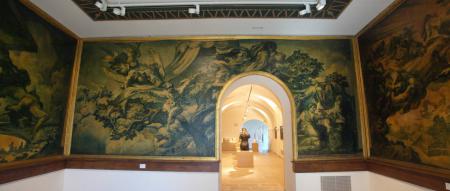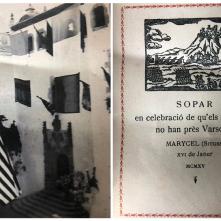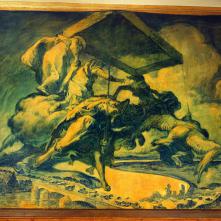The triomf of the Allies: testimonials of the Great War (1914-1918) in the Museus de Sitges
On 12 November 1918, the headlines of most of the newspapers of Barcelona shared the same title: the victory of the allies. It was the day after the signing of the armistice between France and Germany. An armistice that, beyond the cease-fire, meant the end of four years of bloody struggle and the sacrifice of many millions of lives and hopes. One of the headlines also corresponded to the chronicle published in a newspaper, probably La Publicidad , on the impact of events in Sitges: " The victory of the allies. Awesome demonstration. Telegram to M. Clemenceau. Mítin at the Casa del Pueblo. Hurray to Belgium! ".
Flags and murals
And it was true, because beyond the chronicle and the corresponding stories in the El Eco of Sitges and Baluard de Sitges, an image immortalizes the euphoria of the afternoon of November 11: that of the North American flag shining in the balcony of the residence of Charles Deering - the wrought iron balcony from Santa Coloma de Queralt and installed on the facade of the Square of San Joan in 1916 - and, in front, two large flags of France hanging from the windows of the Maricel Palace above Puerta de Salamanca. The poles of the flags of allied countries under the windows of the facade of the Palace gave the building a festive and solemn air.
Miquel Utrillo, looking forward to the development of war and the expectation of the end, had arranged all the scenography of the celebration. The owner of the great Maricel ensemble, however, was not there. Charles Deering had left Sitges in late August 2016 and had not returned because of the presence of German submarines in the waters of the Atlantic. In those hours he enjoyed the victory of the allies in his mansion in Cutler, Florida.
A few days before his departure, the artist Josep M. Sert installed one of his most important murals and one of the most emblematic works of the residence of Charles Deering in Sitges: the great set that premonitely represented the triumph of the allies; this denomination happened to characterize the great vestibule of Maricel where initially Deering had saved its automobile. The Sert Hall is still one of the most significant places in the history of this great artistic and architectural ensemble..
Deering and Utrillo could have never envisaged towards 1913, when the residence of the American collector grew in volume and quality of his content and decided to entrust some work to Sert, the most fashionable designer painter in Paris, that the hall painted by the artist. represented one of the most important events of the century. The commission took place in 1915, with the tower of Sant Miquel and the bridge that linked the residence and palace enjoyed full glory. Shortly after Sert presented to Deering and Utrillo the sketches of the order, which took a year to fulfill. He carried out six works, each with his title, some of which were premonitory and the result more of the desire than of the reality of the moment: A problem has emerged in Europe, The mobilization of war, The miracle of St. Genevieve, Victory comes slowly, The defeat of the enemy and The final victory of the 1914 war.
The paintings were installed the next day of the 1916 Festa Major or Town Festivity, in the presence of two prominent French authorities of the moment and friends of Utrillo: Jules Pams , French senator and excandidate in the Republic, and the Eastern Pyrenees MP Emmanuel Brousse. For Deering it was an important event - even published by the Herald Tribune in New York -, as well as the recognition that three days before the Sitges Town Council had appointed him Adopted Son with the granting of the " a plate modeled by Josep Llimona. At the moment, the bronze plate is at the porch of the entrance of his residence in Deering Estate, the Stone House. Since then, Sert Hall has been known as a whole as The Triumph of the Allies.
When in 1921 Charles Deering moved his art collection and went to the United States, he took, among many other works of art, the fabrics of Sert. The destination of the work was not that of the collection of Gothic altarpieces of Catalan and Hispanic art, among other pieces, immediately coveted by the Art Institute of Chicago. Fortunately, after the years they were located and recovered by Dr. Jesús Pérez-Rosales, to whom Sitges owes the return to its original place of this important and emblematic ensemble.
Activism, friendships and testimonials
During the Great War, Maricel was an important focus of Allied activism. The sympathies and complicities of Utrillo with France and the American nationality of its owner came together in an interesting position that was openly pronounced. The murals of Sert are the main witness but not the only one.
In January 1915 a banquet was held at the Palau to celebrate that the Germans had not been able to take Warsaw. Utrillo's activism in the promotion of the French Art Exhibition in Barcelona in 1917 became crucial. The manifests and supportive actions never lacked the names of Utrillo, Ramon Casas and Santiago Rusiñol, united by the memory of the days that had lived a Bohemian live in Montmartre and for the appreciation of France, that for them and many other Catalan artists also mobilized for the cause, was the fatherland of art and freedom. All three participated in several expeditions of brotherhood and support. Rusiñol, in addition, contributed with his sharpened and sensitive writings. In just correspondence to all three they were granted the French Legion of Honor. The ceramic vase of the sculptor Gustau Violet, which is kept at the Maricel Museum for the delivery of the Legion of Honor to Utrillo, carries the dedication of "the most Catalan of the French to the most French of Catalans".
The memory and propaganda about some of the protagonists of the Great War was not lacking. When the young sculptor Jou worked on the capitals and ornaments of the windows of the last building section of the Maricel set, the reconversion of the Trowbridge houses in the prolongation of the Palace, he sculpted the allegories of war and peace , the portrait of the sculptor Gustau Violet dressed as a soldier and that of the nurse Edith Cavell, shot by the Germans under the accusation of espionage, one of the most popular events in the rear.
In the Museu del Cau Ferrat they are exhibited, in addition to the diploma of the Legion of Honor awarded to Rusiñol - given by his great-grandparent Norman Cinnamond on the occasion of the Rusiñol Year, in 2006- two singular objects. Two helmets of enemy soldiers of the Great War, that of a French and a German, from the fronts of war that visited Utrillo and Rusiñol. One hundred years after the armistice they rest together, one next to the other, at a bench in the Temple of Modernism.
Vinyet Panyella i Balcells


 Buy tickets
Buy tickets Buy tickets
Buy tickets





